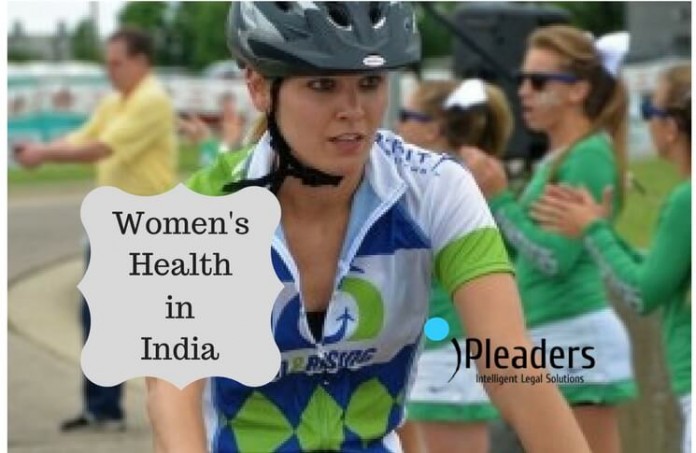This article on “Why Women’s Health is a Huge Concern Today?” is written by Ishita Mehta.
With an increasing number of disease and illness, women’s health is degrading day by day. There is an acute need to adopt early diagnosis and early treatment for women. Poor health brings out problems not only for women but also for their families.
In this article, I am going to talk about how women have been major targets in different programs, facilities and how a women’s health is a major concern today.
This article will bring into notice the sterilization deaths in India, needs for more than just a sanitary napkins and will bring into focus the social workers who’re spreading awareness about the needs of women and girls in today’s time and their right to abortion in the context of gender equality.
Suggestive Read: Is abortion legal in India?
The article below brings in light the major areas that need focus to create a clean and healthy atmosphere around women.
Sterilization Deaths In India
We are all well known about the sterilization deaths in Chattisgarh which happened in the year 2014.
Sterilization is the process of closing of the woman’s Fallopian tubes. Sterilization process is permanent in nature. Tubal ligation is the process for sterilization and it is not considered a temporary form of birth control.
The tragedy was the death of 14 women who lost their lives post tubectomy (process for sterilization)- led under horrendous conditions. It requires a more profound investigation. All these women underwent the operation at a family planning camp organized by the state government.
There Are Guidelines Related To The Number Of Operations And Surgeries Done, which says-
- Not more than 10 surgeries can be done in a day.
But, in this medical camp, Dr. R K Gupta performed in total of 83 surgeries with only one instrument in five hours.
- The instrument after every surgery needs to be cleaned and it was not done by the doctor, that resulted in death of 14 women.
India has a dark history of sterilization- targeting the poor and the unprivileged.
For decades, India has relied on female sterilization as a primary mode for contraceptive.
Prime Minister has taken a major step towards modernizing that system, by introducing-
- Injectable contraceptives free of charge in government facilities.
The World Health Organization recommends their use without restriction for women of childbearing age.
Apart from these, there have been new birth control options added by the international organizations.
All these new methods are tried on women who do not know any other resource to go for private healthcare facilities.
In Chhattisgarh, many women due to lack of money traveled from their villages to get the incentive of cash worth Rs 1,400/-
There are drawbacks of sterilizations which have been admitted by the health care facilities. India’s population is increasing due to unwanted reasons and government, with respect to control of the human population, which is rapidly growing.
India has the 3rd largest female sterilization rate.
Contraceptive methods Degrading Women’s Health
A more intensive take a gander at various gadgets received to push family arranging in India uncovers that, all projects are tilted against women’s health.
- Other than the male sterilization outrage made by the decision party in 1977, each and every innovation in the family arranging program has been focused against ladies.
- Most of the oral pills utilized as a prophylactic gadget by women are Schedule L drugs, which are denied from being publicized.
However, they have been publicized on TV.
The WHO additionally sets out that-
- The lady must know about the reactions occurring out from utilization of the pill.
- She should recognize what she is ought to do on the off chance when she has neglected to take the pill.
- To add to this, in 2006, the legislature allowed the ECP (Emergency Contraceptive Pill) to be utilized as a helpful type of contraception in the event that women have neglected to take insurance amid sex.
This is unreservedly promoted crosswise over TV screens in the nation.
Youthful urban young ladies take a gander at it as their flexibility to pick ‘the following morning’ pill, which was denied to them for very long.
Long term abuse as per specialists are as yet being contemplated.
Additionally, there are basic reactions like- queasiness, spewing, cerebral pain, stomach dying, unpredictable menstrual cycles. Long term impacts are as yet being contemplated.
Intra Uterine Device Degrading Women’s Health
The another contraceptive method is Intra Uterine Device which is degrading women’s health in its own way.
Women have been a major targets of all these programs, especially the women who have no knowledge of the consequences which can arise.
Intra Uterine Device is temporary in nature. These are economical contraceptives.
Women have been a major targets of all these programs, especially the women who have no knowledge of the consequences which can arise.
Women Need Just More Than A Sanitary Napkin
Only giving napkins will not solve this issue. What we need here is an initiative to render more education to rural girls about the menstrual cycle and how the body works during periods.
Rural area women and young girls need just more than the sanitary napkins.
Only giving napkins will not solve this issue. What we need here is an initiative to-
- Render more education to rural girls about the menstrual cycle and how the body works during periods.
- More than that, render more education about sex education and get them cleaner toilets with water supply.
As,
- Most of the rural girls use cloth which is not that effective as a sanitary napkin, as the cloth only absorbs like 7% of the blood flow.
- 20% of the Rural girls don’t even have the idea of when their menses begin and few of them don’t even use toilet due to the fear of stains.
But, the major question here is- what is the point of giving young girls sanitary napkins as there are no clean toilets?
But, the major question here is-what is the point of giving young girls sanitary napkins as there are no clean toilets?
There is a solution to all this. We need more of biodegradable, low cost pads.
There is a lot of promising and emerging development happening in India regarding this issue.
There is a lot of tribal population and the people below poverty line who are the worst affected in terms of livelihood security as well as health outcomes.
- As a part of maternal health benefits they are motivating women to eat better and get pre-natal and the post natal check ups.
- They’re given awareness to immunize their children.
We all know that healthy mothers can ensure a better future for their children.
- Maternal health is a key issue these days and it needs to be taken care of.
- The main responsibility is to spread awareness regarding various schemes and regulations regarding the rights and facilities available to women which will ensure women’s health.
This also involves the knowledge about how the hospitals should run.
People in rural area believe that during pregnancy the mother should not eat more and stay limited with the food habits just because they fear that the baby would grow too big. There are a lot of myths like this that people need to be made aware about.
Prohibition Of Sex Selection
The two acts that regulate sex determination and abortion separately are-
- The Pre-Conception And Prenatal Diagnostic Techniques (Prohibition of Sex Selection) Act 1994, and
- The Medical Termination of Pregnancies (MTP) Act, 1971.
The Medical termination of pregnancies(MTP) Act, 1971 says that-
There should be limited right for women regarding the abortion process and it should be limited to only certain provisions.
The Pre conception and Prenatal techniques monitor the strategies of abortion and it has been directed against pre- birth determination and sex selection.
As per the techniques, concentrating on the supply side of dishonest and unlawful therapeutic practices would counter sexual orientation one-sided sex determination.
With sufficient care, it would help the privilege to protected and legitimate abortion for women.
There is a consistent concession to the way that is opposed to following pregnancy, i.e.
- There must be frameworks set up to watch out for centers and symptomatic offices in a deliberate way.
- Moreover, knowledge should be provided to ladies and their families of any maternity facility in the urban territories and in addition in the rustic focuses.
Both the laws must be actualized truly alongside all other sexual orientation benevolent laws to make it feasible for ladies and young ladies to lead an existence of fairness, nobility and agreement.
Conclusion
Taking birth as a women in India is a challenging thing hence, they’re facing a lot of medical issues, especially rural women, as they are not aware about the certain things that women should know about their health.
The health situation in our nation is quickly changing, both regarding the general health challenges that we confront and in addition, our reaction to these difficulties.
- As India turns out to be more developed and we have more prominent means available to us, our reaction to our health’s challenges must mirror our changing health and financial status.
- India faces huge difficulties in the range of women’s health.
- India is one of only a handful couple of nations that has recorded generous decrease in maternal mortality.
- India is still a long way from accomplishing the objective set in the thousand years improvement objectives.
Around 75% of health foundation, medicinal labor, and other well-being assets are moved in urban territories where 27% of the population live.
The concentration of general health is to achieve change at the arrangement level for averting ailment as well as for the women’s health advancement and to focus on public health and promotion.
Women today are more independent and liberated than the earlier era. They have totally redefined gender roles and have proven their potential but, in the process of fighting gender equality, women’s health is at a toll.
This’s all about “Why Women’s Health Is A Huge Concern Today?” Did you find the post effective? Do write to us in the comment box below.
Don’t forget to Share the article in your network!!
 Serato DJ Crack 2025Serato DJ PRO Crack
Serato DJ Crack 2025Serato DJ PRO Crack










 Allow notifications
Allow notifications



